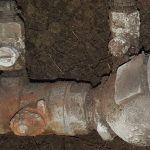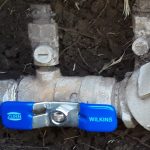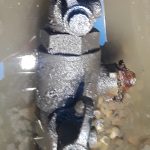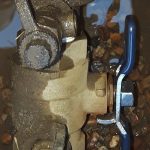 All irrigation systems in Texas need a backflow device installed at the beginning of the system, usually near the water source, like a water meter. A majority of the systems have a double check assembly (DCA). Some have a reduced pressure principle device (RPZ) or a pressure vacuum breaker (PVB, SVB), but this depends on the municipality, geographical location in the state, and whether the system is considered a high hazard or not.
All irrigation systems in Texas need a backflow device installed at the beginning of the system, usually near the water source, like a water meter. A majority of the systems have a double check assembly (DCA). Some have a reduced pressure principle device (RPZ) or a pressure vacuum breaker (PVB, SVB), but this depends on the municipality, geographical location in the state, and whether the system is considered a high hazard or not.
 If you have a double check assembly installed, it is likely in a green rectangle box and in the ground. It tends to get buried over time which makes the handles unusable unless the box is cleaned out around the device. It is also likely the handles will be rusted, corroded, or completely gone.
If you have a double check assembly installed, it is likely in a green rectangle box and in the ground. It tends to get buried over time which makes the handles unusable unless the box is cleaned out around the device. It is also likely the handles will be rusted, corroded, or completely gone.
These handles are critical in isolating the irrigation water from the house water. They are also critical in turning off the mainline due to an irrigation mainline leak that is gushing non-stop or when servicing a control valve.
 I would suggest checking your handle status at least once a year. Clean around them as needed. If it turns out the handles can’t beused due to their condition, they should be replaced. You could, of course, replace the whole device, but that can be expensive. And if the device isn’t up to current state code, it will need to be brought up to code with all the required permits, inspections, and backflow testing.
I would suggest checking your handle status at least once a year. Clean around them as needed. If it turns out the handles can’t beused due to their condition, they should be replaced. You could, of course, replace the whole device, but that can be expensive. And if the device isn’t up to current state code, it will need to be brought up to code with all the required permits, inspections, and backflow testing.
 I offer a handle replacement service that is not expensive compared to a full device replacement. I carry the tools and supplies needed to replace both handles on the spot. It usually takes less than two hours and includes box clean up around the device, handle removals, grinding and rethreading brass stems, handle installations, and handle testing to make sure the valves isolate the main line properly.
I offer a handle replacement service that is not expensive compared to a full device replacement. I carry the tools and supplies needed to replace both handles on the spot. It usually takes less than two hours and includes box clean up around the device, handle removals, grinding and rethreading brass stems, handle installations, and handle testing to make sure the valves isolate the main line properly.
Updated 12/23/2022
Contact me here to make an appointment.